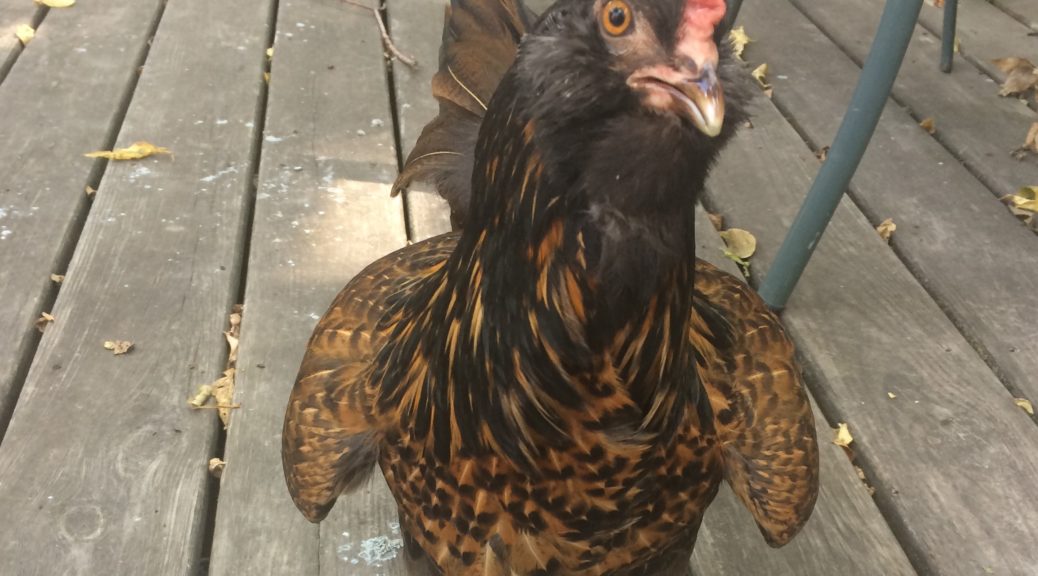
Impacted Crop in Chickens
A couple months ago something happened here at The Way Homestead that I haven’t written about until now. Life with animals can be unpredictable, and even more so with livestock. Sometimes something happens that’s out of your control, and you lose an animal – or think you might. The day Bijou had an impacted crop was one of those times.
Earlier Scare
I’ve had chickens for about eight months now, and in that time we’ve had two big scares with our girls. Both times it was Bijou, my Easter Egger, that worried us. The first was when the chicks were around 12 weeks old; I wrote about it here. They had only been out in their big coop for about a week. One night when I went to lock them up, Bijou was nowhere to be found. I thought for sure a hawk must have taken her, or she had somehow gotten outside the fence. I was frantic. The whole family ran around the neighborhood for half an hour, calling for a chicken, before I finally found her… roosting under our deck. Everything was fine, but I learned quickly how scary it is when one of your chickens is in danger!
Concerning Behavior
This time the troublemaker was Bijou once again, though it wasn’t her fault. I always let my chickens out to free range in the backyard around noon, and this day in mid-September was no exception. I ran out to do a quick egg check and let them loose, but before I even got the run open, I realized something was wrong. Bijou was making an intermittent whistling, almost wheezing noise. Other than the sound, she was moving and acting normally.
(Ironically enough, this was the same day Pepper, my Barred Rock, finally decided to lay her first egg! Did I mention that chickens are full of surprises?)
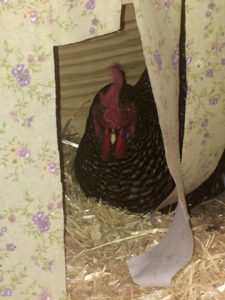
Between checking on Pepper and worrying about Bijou, I spent the rest of the afternoon outside with the chickens. As time went on Bijou seemed to get worse. Her comb was still a nice dark pink color, which reassured me that she was getting enough oxygen. (A pale pink or purple comb is often a sign of an emergency, and you should get your chicken to a vet right away). But the wheezing was not intermittent now; it was almost constant. She spread her wings out from her body, and kept her mouth open like she was panting. She was clearly in distress. I took this video to share with you:
What’s an Impacted Crop?
It was, honestly, quite terrifying. My gut told me that something was stuck in her throat or crop. A crop is a small pouch in a chicken’s esophagus, where food is stored before moving to the stomach. You can usually feel the crop at the base of a chicken’s neck, just right of center. It’s easiest to feel if she’s just eaten. Normally the crop is about the size of a golf ball when it’s full, and it often feels bumpy from the food or gravel inside. (Because they don’t have teeth, chickens, like all birds, swallow small rocks called grit to help grind up food in their gizzard. If your birds don’t free range, you will need to provide grit for them.) You can see the crop and gizzard in this illustration of a chicken’s digestive system:
I felt Bijou’s crop and noticed that it was very full and firm. If you watch the above video again, you can even see that her crop is protruding! Somewhere in my brain the phrase “impacted crop” popped up. An impacted crop occurs when the crop gets blocked. This can happen when a chicken eats something they shouldn’t – straw, string, food that’s too large, etc. (Another reason not to use straw as bedding.) It can also happen if the food in the crop doesn’t have enough moisture. I hadn’t seen Bijou eat anything strange, but the sounds she made coupled with a large, hard crop let me know something was definitely wrong.
How To Help A Chicken With An Impacted Crop
The best thing to do for an impacted crop is to try and move along whatever is stuck. I tore bread into tiny pieces and soaked it in olive oil. The bread would provide fiber to help push the food along, and the oil would lubricate the food and her esophagus. I was counting on Bijou’s love of treats, and it worked – she ate the bread happily. Normally you don’t want to feed a chicken high-fat foods, but in this situation the pros outweighed the cons. When she lost interest in the bread, I sprinkled a few meal worms on top to persuade her to eat a little more.
It’s important for food in the crop to have enough moisture to be able to pass. Impacted crop or not, water is always the most important thing to provide for your chickens. So I gave Bijou a bowl of water in addition to the bread, but she wouldn’t drink. Finally I got a plastic syringe (the kind used for baby medicine), and gently squirted water down her throat. She wasn’t thrilled with that, but it did the trick. I massaged her crop carefully, in a circular motion.
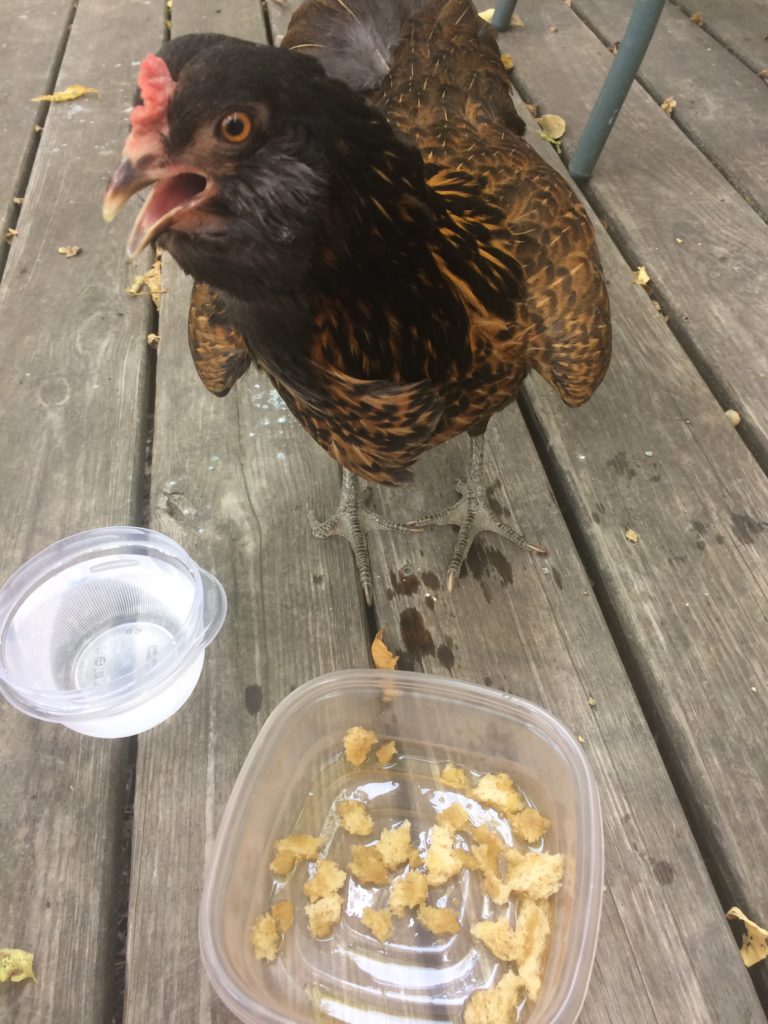
Watching Carefully
I watched Bijou carefully for the rest of that day and the next. The wheezing/squeaking lessened significantly after feeding her the olive oil bread and water. Her crop became less swollen, and she began to act more normally. By nightfall I was still worried about her, but she was no longer panting or holding her wings out. I felt it was safe to leave her in the coop overnight. The next day she still had a scratchy voice – she sounded like a person with a sore throat! Otherwise she seemed perfectly fine. By the next day, there was no sign that anything had ever been wrong. She was eating, drinking, laying eggs, and scavenging for food normally. I was immensely relieved!
Emergency Situations
Often an impacted crop will resolve on its own or with a little help from you, as described above. But if you have a chicken with an impacted crop and you can’t get it to pass, veterinary care and surgery may be required. If your chicken shows other signs of illness – she’s lethargic, her comb is turning blue, she can’t stand up, or seems unable to breathe – this is an emergency. Get her to a vet right away! If your chicken isn’t in immediate danger but she shows no signs of improvement after a day or two, you should also take her in. An impacted crop can lead to death if not treated.
Thinking that you might lose an animal is a terrible feeling. Thankfully an impacted crop is a fairly easy problem to fix. I hope that if you’re ever in the same situation, this post will help you understand what’s happening and what you can do to help.
(Update on Pepper – She did lay her first egg that day! The joys of keeping chickens always outweigh the troubles.)
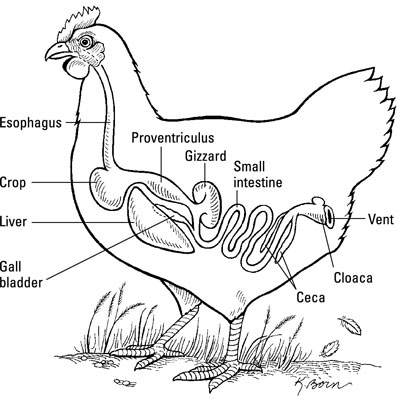
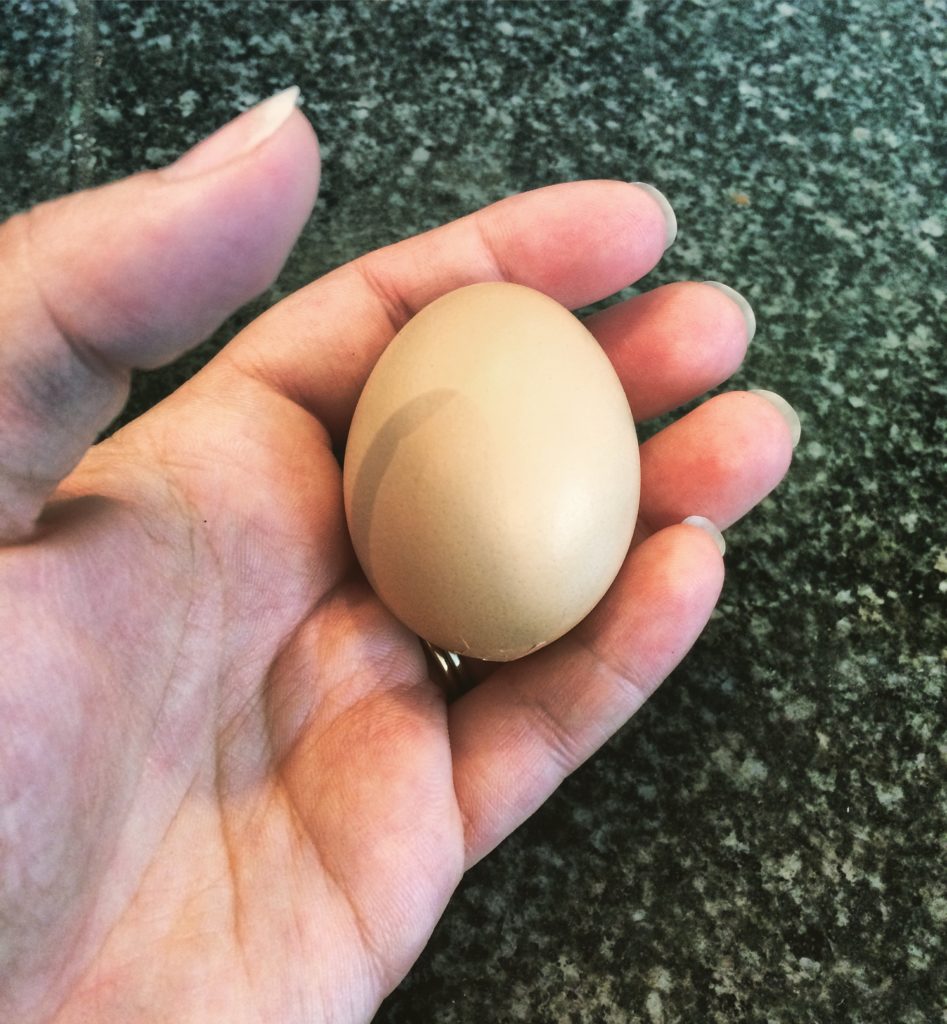
2 thoughts on “Impacted Crop in Chickens”
THANK YOU FOR THIS INFO. BUT NOW I NEED TO KNOW WHAT TO DO IF YOUR HEN HAS BEEN LAYING VERY SOFT, JELLY EGGS FOR MONTHS NOW AND IS EATING OYSTERS SHELLS ALL THE TIME, AND THE EXTRA CALCIUM ISN’T HELPING ?
I’m sorry to hear that! We’ve gotten a soft egg once or twice, but always from a brand new layer. I can’t imagine it going on for months. Here’s a list of possible causes I found. Hopefully something on there will help you figure out a cause and solution! https://thefrugalchicken.com/chickens-laying-soft-eggs/